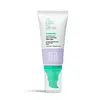What's inside
What's inside
 Key Ingredients
Key Ingredients

 Benefits
Benefits

 Concerns
Concerns

 Ingredients Side-by-side
Ingredients Side-by-side

Water
Skin ConditioningGlycerin
HumectantOctocrylene
UV AbsorberCetyl Ethylhexanoate
EmollientEthylhexyl Methoxycinnamate
UV AbsorberButylene Glycol
HumectantCetearyl Alcohol
EmollientDimethicone
EmollientCI 77891
Cosmetic ColorantC14-22 Alcohols
Emulsion StabilisingSodium Acrylate/Sodium Acryloyldimethyl Taurate Copolymer
Emulsion StabilisingPotassium Cetyl Phosphate
EmulsifyingCeteareth-2
EmulsifyingCeteareth-21
EmollientPhenoxyethanol
PreservativeIsohexadecane
EmollientC12-20 Alkyl Glucoside
Emulsifying3-O-Ethyl Ascorbic Acid
Skin ConditioningSilica
AbrasivePolysorbate 80
EmulsifyingNiacinamide
SmoothingTriethoxycaprylylsilane
Alumina
AbrasiveXanthan Gum
EmulsifyingSorbitan Oleate
EmulsifyingDisodium EDTA
CI 19140
Cosmetic ColorantCentella Asiatica Extract
CleansingTheobroma Cacao Seed Extract
AntioxidantWater, Glycerin, Octocrylene, Cetyl Ethylhexanoate, Ethylhexyl Methoxycinnamate, Butylene Glycol, Cetearyl Alcohol, Dimethicone, CI 77891, C14-22 Alcohols, Sodium Acrylate/Sodium Acryloyldimethyl Taurate Copolymer, Potassium Cetyl Phosphate, Ceteareth-2, Ceteareth-21, Phenoxyethanol, Isohexadecane, C12-20 Alkyl Glucoside, 3-O-Ethyl Ascorbic Acid, Silica, Polysorbate 80, Niacinamide, Triethoxycaprylylsilane, Alumina, Xanthan Gum, Sorbitan Oleate, Disodium EDTA, CI 19140, Centella Asiatica Extract, Theobroma Cacao Seed Extract
Water
Skin ConditioningDicaprylyl Carbonate
EmollientEthylhexyl Methoxycinnamate
UV AbsorberPropanediol
SolventDibutyl Adipate
EmollientButyl Methoxydibenzoylmethane
UV AbsorberEthylhexyl Triazone
UV AbsorberBis-Ethylhexyloxyphenol Methoxyphenyl Triazine
Skin ConditioningC20-22 Alkyl Phosphate
EmulsifyingC20-22 Alcohols
Emulsion StabilisingBenzotriazolyl Dodecyl P-Cresol
UV AbsorberPolyacrylate Crosspolymer-6
Emulsion StabilisingCaprylyl/Capryl Glucoside
Cleansing1,2-Hexanediol
Skin ConditioningPanthenol
Skin ConditioningAllantoin
Skin ConditioningParfum
MaskingPhysalis Angulata Extract
Skin ProtectingTocopheryl Acetate
AntioxidantXanthan Gum
EmulsifyingCaprylic/Capric Triglyceride
MaskingDisodium EDTA
Sodium Hydroxide
BufferingO-Cymen-5-Ol
AntimicrobialSodium Hyaluronate
HumectantBHT
AntioxidantTocopherol
AntioxidantPantolactone
HumectantCI 19140
Cosmetic ColorantCI 42090
Cosmetic ColorantWater, Dicaprylyl Carbonate, Ethylhexyl Methoxycinnamate, Propanediol, Dibutyl Adipate, Butyl Methoxydibenzoylmethane, Ethylhexyl Triazone, Bis-Ethylhexyloxyphenol Methoxyphenyl Triazine, C20-22 Alkyl Phosphate, C20-22 Alcohols, Benzotriazolyl Dodecyl P-Cresol, Polyacrylate Crosspolymer-6, Caprylyl/Capryl Glucoside, 1,2-Hexanediol, Panthenol, Allantoin, Parfum, Physalis Angulata Extract, Tocopheryl Acetate, Xanthan Gum, Caprylic/Capric Triglyceride, Disodium EDTA, Sodium Hydroxide, O-Cymen-5-Ol, Sodium Hyaluronate, BHT, Tocopherol, Pantolactone, CI 19140, CI 42090
 Reviews
Reviews

Ingredients Explained
These ingredients are found in both products.
Ingredients higher up in an ingredient list are typically present in a larger amount.
CI 19140 is also known as Tartrazine. Tartrazine is a synthetic dye used in cosmetics, foods, and medicine to add a yellow color.
Tartrazine is created from petroleum and is water-soluble.
Some people may experience allergies from this dye, especially asthmatics and those with an aspirin intolerance.
Learn more about CI 19140Disodium EDTA plays a role in making products more stable by aiding other preservatives.
It is a chelating agent, meaning it neutralizes metal ions that may be found in a product.
Disodium EDTA is a salt of edetic acid and is found to be safe in cosmetic ingredients.
Learn more about Disodium EDTAEthylhexyl Methoxycinnamate is an organic compound that provides UVB protection. It often goes by the more common name of octinoxate. It is created from methoxycinnamic acid and 2-ethylhexanol.
Ethylhexyl Methoxycinnamate absorbs UVB rays with wavelengths between 280-320 nm. UV absorbers protect your skin by using chemical reactions to convert UV rays into heat and energy.
UVB (290-320 nm) rays emit more energy than UVA rays. They are capable of damaging DNA, causing sunburns and are thought to be linked to skin cancer.
The state of Hawaii has banned sunscreens containing octinoxate due to its potential impact on coral reefs. More research is needed to bridge gaps in this research. The European Union allows higher levels of octinoxate in sunscreens than the US and Australia.
Ethylhexyl Methoxycinnamate is oil soluble. It is not stable and may lose efficacy when exposed to sunlight.
Learn more about Ethylhexyl MethoxycinnamateWater. It's the most common cosmetic ingredient of all. You'll usually see it at the top of ingredient lists, meaning that it makes up the largest part of the product.
So why is it so popular? Water most often acts as a solvent - this means that it helps dissolve other ingredients into the formulation.
You'll also recognize water as that liquid we all need to stay alive. If you see this, drink a glass of water. Stay hydrated!
Learn more about WaterXanthan gum is used as a stabilizer and thickener within cosmetic products. It helps give products a sticky, thick feeling - preventing them from being too runny.
On the technical side of things, xanthan gum is a polysaccharide - a combination consisting of multiple sugar molecules bonded together.
Xanthan gum is a pretty common and great ingredient. It is a natural, non-toxic, non-irritating ingredient that is also commonly used in food products.
Learn more about Xanthan Gum